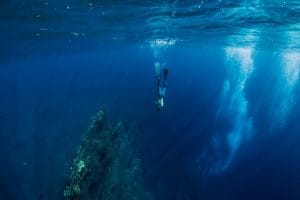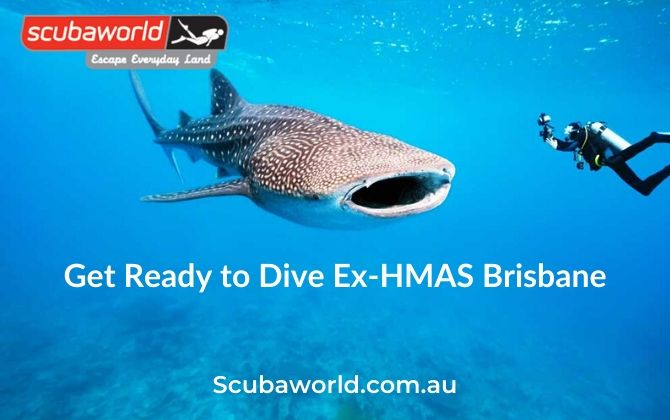
Why Scuba Divers Should Try Freediving: A Personal Perspective from an Scuba diving and Freediving Instructor
Hey everyone, I’m Matt, co-director of OceanSense Freediving here on the Sunny Coast. Over the

For many budding divers, visiting the site of the ex-HMAS Brisbane is a bucket list destination. The former navy vessel that lies off the coast of Mooloolaba, about 80 miles north of Brisbane, is submerged under 28 metres of water, making it an ideal location for a spot of diving.
The ship was originally a guided-missile destroyer but was decommissioned and then sunk. Over the years since it hit the bottom of the ocean, it’s become something of a man-made reef, playing host to dozens of exotic marine species. Today, it is one of the most famous wrecks in the country, owing in part to its accessibility. It lies just 2.9 miles from the coast in relatively tranquil waters that stay above 17 degrees all year round.
Diving down to see the wreck, however, is no walk in the park. Here’s how to get ready for your Ex-HMAS Brisbane dive.
Current rules state that all divers wanting to explore the Ex-HMAS Brisbane wreck must have a recognised scuba qualification of one kind or another. The more advanced the qualification, the more of the wreck divers can explore.
Open water level certificate divers can descend to the wreck itself, while advanced wreck divers can travel inside.
Scuba World offers a range of scuba diving courses that can help you get ready to dive Ex-HMAS Brisbane.
The great thing about these courses is that you can complete them both full-time and at weekends. Classes typically involve around five to six hours of training followed by exams and two real-world boat dives.
There are some additional prerequisites for becoming a qualified diver. First, you need to demonstrate that you can swim more than 200m and can stay afloat for 10 minutes. You may also need a diver’s medical if you are over the age of 45 or have a body mass index over 30 and a waist circumferences of more than 102 cm for males, 88 cm for females.
The wreck of Ex-HMAS Brisbane lies within the Ex-HMAS Brisbane National Park. The park, however, isn’t like others in the country. If you want to enter, you have to gain written approval or a permit, regardless of whether you are a vessel, diver, or snorkeler.
Most people who want to dive down to see the wreck, therefore, book a dive tour with a diving company. Here the diving business takes care of the hassle of dealing with the authorities and you’re able to get on and book.
Most diving companies have moorings attached to the boat that they use to assist divers on their way down to the depths. Many also provide lights and scuba gear, allowing you to get the best view possible of the wreck.
Because Ex-HMAS Brisbane National Park is a restricted area, you have to obtain something called a Queensland Parks and Wildlife Service (QPWS) permit. These permits are for private divers, club divers, and snorkelers who use the public moorings. Most licensed tour operators can issue these permits, allowing you to get one when you book a tour.
If you plan on diving the ex-HMAS Brisbane, you’ll also need to bring some equipment with you.
The temperature of the water along the sunshine coast ranges between 17 and 27 C between summer and winter. Most divers, therefore, bring a two-piece 5 mm wetsuit with them to protect them while they are in the water.
You’ll also need to bring a range of other equipment with you, suitable for dives of depths up to 50 metres. Remember, ex-HMAS Brisbane lies more than 28 beneath the surface, meaning that any diver is at risk of the bends.
We recommend that divers collect all of the equipment that they need before venturing forth. This includes high-performance Aqua Lung regulators, computers, a well-fitting wet suit, masks, fins, torches suitable for underwater use, and suitable boots.
Once you’ve done all of the above, you’re all set for your ex-HMAS Brisbane adventure.
When you arrive at the site of the wreck, you’ll immediately see why it is so famous. The sheer size of the boat makes it an impressive sight to behold. Being so close to the surface means that it has been easy for life to get a foothold on the old, rusting hull. The wreckage is teeming with life, including lionfish, snapper, blennies, nudibranchs and squid.
Are you pumped diving the Ex-HMAS Brisbane? Visit Scuba World for more info.

Hey everyone, I’m Matt, co-director of OceanSense Freediving here on the Sunny Coast. Over the
Join us Thursday 30th Jan at 5:30pm to hear David Mullins talk about nudibranch defences
Dear members, I would like to take this opportunity to inform you about a few